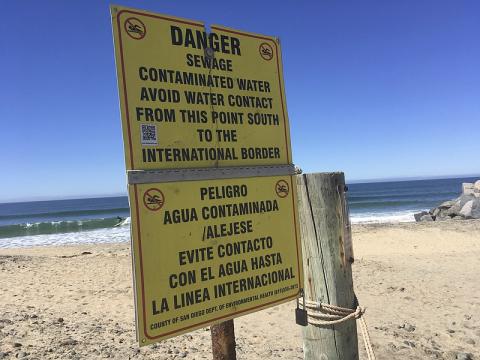<p><br>
Editor-at-Large</p>
<p>The recently signed international trade agreement between the US, Mexico, and Canada included funding to help address raw sewage spilling into San Diego’s waters from Mexico.</p>
<p>President Trump signed the new US Mexico Canada Agreement, called USMCA, on January 29, after nearly a year of negotiations between the three countries. The USMCA replaces NAFTA, passed in 1992, as the binding trade agreement between the three countries of North America.</p>
<p>Among the many international issues addressed in the agreement were environmental problems like the Mexican sewage flow across the border. For years, Mexico has allowed raw sewage to flow into the Tijuana River Valley along the border, and that sewage makes its way into the ocean in Imperial Beach.</p>
<p>It’s estimated that up to 50 million gallons of raw sewage flow into the Tijuana River Valley each day.</p>
<p>Beach closures from Imperial Beach to Coronado occur regularly when the water contaminants reach unhealthy levels. A study in 2017 found that Imperial Beach experienced for than 1,600 beach closures in ten years, resulting in an average of more than one-third of each year having had beach closures.</p>
<p>At a recent press conference, local elected officials pressed the federal government to spend the new funding on a US water treatment plant that would clean the sewage before it pollutes San Diego beaches. San Diego Mayor Kevin Faulconer, Congressman Juan Vargas, Imperial Beach Serge Dedina, and others called for immediate action.</p>
<p>“That $300 million is very, very important,” Congressman Vargas said. “But now it’s very important for us to keep on top of the EPA to make sure they spend it, correctly and here and that’s going to be up to all of us.”</p>
<p>Congressman Vargas, (D-Chula Vista), represents the entire border area from Imperial Beach to the Arizona border.</p>
<p>Imperial Beach Mayor Serge Dedina also called attention to the international problem that impacts his city more than any other.</p>
<p>“The EPA and the International Boundary and Water Commission are doing nothing to get this flow of sewage that’s currently happening to be stopped. They have no plan,” Mayor Dedina said. “They’re not making an effort to do that and so, while all this is good, we have a crisis on our hands.”</p>
<p>This week, two California statewide officials called on the US Environmental Protection Agency (EPA) for immediate action along the border.</p>
<p>California State Controller Betty Yee, who is also the Chair of the State Coastal Commission, signed a letter to the EPA on behalf of the Lands Commission.</p>
<p>“The State Lands Commission is deeply concerned about the latest flows of untreated wastewater into the Tijuana River and the impacts of this pollution on community health and public lands,” Yee wrote. “It is imperative the U.S. EPA collaborates with the Mexican government and International Border and Water Commission to prevent ongoing cross-border pollution and bring a swift end to this crisis.”</p>
<p>California’s Lt. Governor, Eleni Kounalakis, added her support for federal action. Kounalakis also serves on the Lands Commission.</p>
<p>“The US EPA must provide leadership at this critical moment,” Kounalakis said. “The US section of the Tijuana River Valley must be restored so that the health and safety of California’s residents, visitors, wildlife and natural resources are no longer threatened,” she added.</p>
<p>The $300 million allocated in the USMCA is in addition to other funding secured in a December fiscal package passed by Congress. That $1.4 trillion budget includes $25 million for the EPA’s Border Water Infrastructure Program.</p>
Image
Image

Category